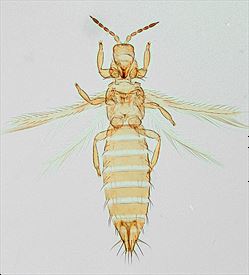
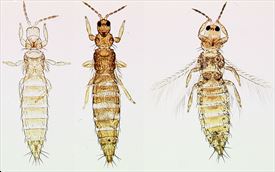
Female microptera, hemimacroptera and macroptera
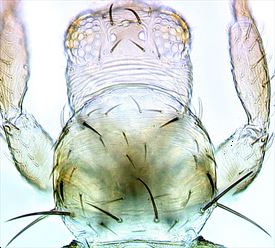
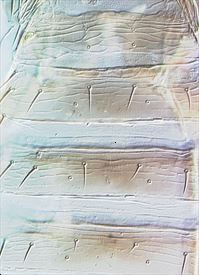
Female tergites I-IV
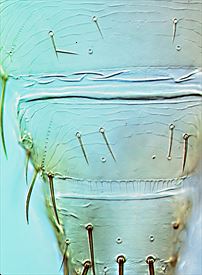
Tergites VII-IX
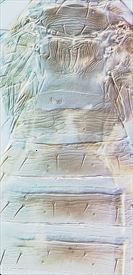
Meso & metanotum, and tergites I-IV
Distinguishing features
Both sexes fully winged, but female also with wings variously reduced in length. Body and legs largely yellow, light brown shadings on thorax and medially on tergites I–VI; major setae brown; antennal segment I yellow, II light brown, III–VII brown; fore wings pale with very faint shading on clavus and at veinal fork. Antennae 7-segmented. Head with ocellar setae pair III stout, arising lateral to first ocellus; postocular setae I slightly longer than III, setae II minute. Pronotum with weak transverse lines of sculpture, 16–20 discal setae all relatively long, also anteromarginal, antero-angular, midlateral and posteromarginal setae S1 unusually long and dark. Mesonotum with anterior campaniform sensilla present or absent. Metanotum with irregular reticulation; median setae arising behind anterior margin, campaniform sensilla present or absent. Fore wing first vein (when present) with 3 setae on distal half, wings variably reduced in length, sometimes no longer than width of pterothorax. Tergite II with 3 lateral marginal setae; tergites II–VII with lines of sculpture between median setal pair, these setae variable in length but usually more than half as long as their tergite; tergite VIII with complete comb of slender microtrichia. Sternites and pleurotergites without discal setae, pleurotergal sculpture lines without microtrichia.
Male similar to female but smaller; sternites III–VII with transverse pore plate.
Related species
The genus Thrips includes 13 species from New Zealand, out of a total of 280 species worldwide (Mound & Masumoto, 2005). Many of these species have the antennae clearly 7-segmented, whereas others have 8 segments. All members of Thrips genus have paired ctenidia on the tergites, and on tergite VIII these are postero-mesad to the spiracles, and they also lack ocellar setae pair I in front of the first ocellus. In contrast, Frankliniella species have ctenidia on tergite VIII antero-lateral to the spiracles, and a pair of setae is always present in front of the first ocellus. T. nigropilosus is unusual within this genus in having the wings variable in length; the median setae on the tergites are also unusually long and dark.
Biological data
Feeding and breeding on the young leaves and in flowers of many plants, this species has been recorded in Europe from Achillea, Chrysanthemum, Lactuca, and Tanacetum [Asteraceae]. In Kenya it has been considered a pest of cultivated Pyrethrum crops.
Distribution data
In New Zealand this species has been collected only in the South Island (NN, BR, MC, CO, SL). It is widespread in temperate areas around the world, including montane areas in Africa. Males are usually rare, but have been recorded from Europe and North America.
Family name
THRIPIDAE, THRIPINAE
Species name
Thrips nigropilosus Uzel
Original name and synonyms
Thrips nigropilosus Uzel, 1895: 198
Thrips laevior Uzel, 1895:199
Thrips lactucae Beach, 1896: 224
Thrips umbratus Priesner, 1920: 59
Thrips pilosissima Priesner, 1922: 92
References
Moritz G, Mound LA, Morris DC & Goldarazena A (2004) Pest thrips of the world – visual and molecular identification of pest thrips. CD-ROM published by CBIT Brisbane. http://www.cbit.uq.edu.au/software/pestthrips/default.htm
Mound LA & Masumoto M (2005) The genus Thrips (Thysanoptera, Thripidae) in Australia, New Caledonia and New Zealand. Zootaxa 1020: 1–64.
Mound LA, Tree DC & Paris D (2012) OzThrips – Thysanoptera in Australia. http://www.ozthrips.org/
Mound LA & Walker AK (1982) Terebrantia (Insecta: Thysanoptera). Fauna of New Zealand 1: 1–113.